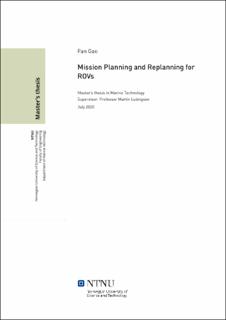| dc.description.abstract | This thesis proposes an autonomous mission planning and control architecture for a Remotely Operated Vehicle (ROV). The architecture aims to develop a mission control architecture and apply automated planning on the system to guide subsea navigations and operations intelligently. Therefore, the ROV could perform more complex and dangerous tasks autonomously without human operators. This mission planning and control system enables autonomous mission execution for general subsea navigation and operations. The proposed architecture increases safety and autonomy, minimizes the need for human intervention, and enables reduction of time and other costs on exploring and exploiting the ocean.
The architecture is developed as a layered mission planning system for global navigation and local operation. The mission planning and control of local operations is a sub-behavior under global navigation missions. The system focuses on the realization of ROV navigation, tracking a Structure of Interest (SOI), subsea operation, and reactive obstacle avoidance in the underwater environment. For this purpose, the designed system is composed of three parts:
(1) An autonomous framework for plan-based mission control and execution: For a given mission request, the system makes plans automatically and executes the planned actions sequentially to achieve the mission goals. This work draws on [36]'s hybrid control architecture for ROVs and develops a plan-based mission control architecture. The sequential steering of behaviors has been changed to plan-based mission control. The coordination mechanism is introduced in the behavior-based reactive layer of the architecture, such that only one reactive behavior is activated from a reasonable selection of all.
(2) A layered mission planning system guides global navigation tasks and local seabed intervention: Based on the current states and the mission request, the planning system automatically generates desired actions to achieve the goal. These actions are developed using the STRIPS planning language. Best-first search (BFS), heuristic search, and fast-forward (FF) search are implemented and tested. A comparison of these search methods shows that the heuristic search has the most satisfactory performance for a simple planning problem. The mission planning is integrated into the autonomous framework to perform mission planning, control, and execution for ROVs. A sub-planner for a specific operation is proposed as a refinement of the action Operation under global navigation tasks.
(3) A re-planning mechanism: Under some circumstances, the action sequence should be adjusted and re-planned to meet new requirements and ensure safety. Three Lookahead algorithms are implemented to trigger repeated planning and re-planning when necessary, after each action is completed, and at all times. For ROVs, a Run-Lookahead algorithm is preferred, which is designed to be sensitive to emergency and failure mode and then do re-planning correspondingly. This method reduces the rate of failure compared to Run-Lazy-Lookahead algorithms and also computational inexpensive compared to the Run-Concurrent-Lookahead algorithm.
The capability and limitations of the architecture are demonstrated through software simulation. Due to the lack of control system on ROV manipulators, the autonomy on operations with the manipulator's arm has not been developed nor physically tested. Control and optimization of autonomous maneuvering should be considered for future research on this subject. The result is a mission planning and control system that automatically generates action sets, which is then executed to steer the ROV to finish missions and perform observation-based operation actions derived from the sub-planner of operation. The mission planner and mission control system can add new actions, remove existing actions, and enable flexibility for more complex missions. | |
